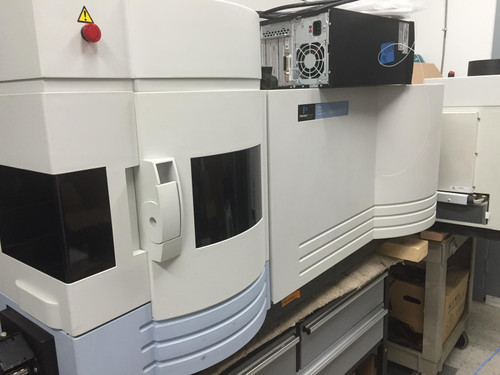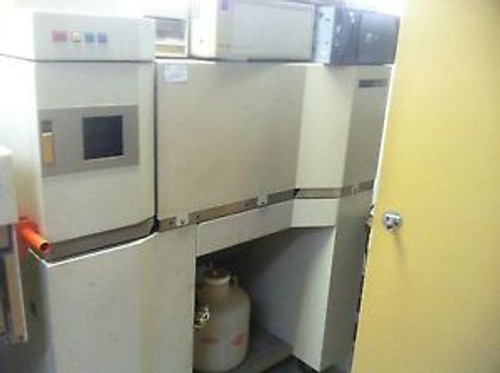Perkin Elmer Optima 4300 DV ICP-OES Refurbished 180 Day Warranty
Spectrometer Specifications
Polychromator The high energy echelle-based Optima polychromator utilizes one or two SCD detectorsdepending on the Optima model. The measured resolution of the system is 0.006 nm at
200 nm. The 80 by 160 mm echelle grating (manufactured by PerkinElmer) has 79 lines per mm and a blaze angle of 63.4 degrees. With the Optima 4300? DV, a 60-degree fused-quartz prism is added as the cross disperser for the visible region (403 - 782 nm). The UV disperser on all Optima 4000 DV series of spectrometers incorporates Schmidt correction into its surface to eliminate aberration for the 400-mm radius camera sphere.
The entire optical system is enclosed in a purged and thermostatted optical enclosure. The optical enclosure is mounted on the same, large optical bench as the sample introduction system.
The optical bench is shock-mounted to the frame of the instrument so that normal floor vibrations do not affect system performance.
Plasma Viewing
With the patented dual-view capabilities of the Optima 4000 DV series (U.S. Patent No.5,483,337), viewing of the plasma is accomplished by computer control of a mirror located in the optical path and allows selection of axial or radial view and adjustment of the plasma viewing in both the vertical and horizontal planes. The viewing position can be optimized by the software.
Shutter and Hg Recalibration System
The computer-controlled, pneumatically operated shutter automatically opens and closes for each sample. By closing the shutter between each sample, the first transfer mirror is rotected from long exposures to the intense UV radiation of the plasma, thus extending the useful lifetime of the mirror. A mercury lamp is built into the shutter mechanism and can be viewed when the shutter is closed to monitor the mercury emission line at 253 nm and automatically update the system wavelength calibration. Frequency of the automatic recalibration is user-selectable between 0 and 1000 minutes and can be varied during an autosampler analysis.
Detector
The patented PerkinElmer Segmented-array Charge-coupled Device (SCD) detectors (U.S.Patent No. 4,820,048)) consist of 235 addressable subarrays, with over 6000 pixels on a 13 by 19 mm silicon substrate. Typical readout noise is about 13 electrons RMS; dark current is less than 100 electrons/pixel/second; and readout speed is 50 µsec/pixel. Correlated doublesampling data acquisition electronics further reduce electronic noise.
ICP System Specifications
RF Generator
The Optima 4000 DV ICP-OES systems feature a 40-MHz, free-running solid state (no power amplifier tube needed) RF generator, adjustable from 750 to 1500 watts, in 1 watt increments.
The power efficiency is greater than 77% with <0.1% variation in output power stability. The solid-state components significantly increase reliability, and can result in higher signal/power readings than conventional tube generators. The compact RF supply meets all FCC certification requirements for RF emission (Part 18 of FCC rules and Regulations). Also complies with EC and VDE 0871 Class B requirements.
Ignition and Power Control
Plasma ignition is computer-controlled and totally automated. A unique software feature allows the plasma to be ignited automatically at a user-determined time, warming the system up prior to an analysis, and can be turned off automatically after an analysis. True Power Control maintainsthe plasma power at the set point, even when changing sample matrices.
Safety Interlocks
For user safety and system protection, the system constantly monitors water flow, shear gas pressure, argon pressures, sample compartment door closure and plasma stability, and displays the interlock status on the computer screen as graphic symbols. If an interlock is interrupted, the plasma will automatically shut down safely.
Cooling Water
A water recirculating cooling system is required, with approximately 4 L/min flow capacity at 310 to 550 kPa and a temperature between 15 °C and 25 °C. A Neslab CFT 75D or equivalent is recommended.
Gas Flow Controls
Argon Flow
Computer-controlled solenoid valves are used to regulate the flow automatically within the rangeof 0-20 L/min in 1-L/min increments for plasma argon and 0 to 2.0 L/min in 0.1-L/min incrementsfor auxiliary argon. A mass flow controller is supplied with all systems for the nebulizer argonflow and is variable between 0 and 2.0 L/min in 0.01-L/min increments.
Shear Gas
A compressed air shear gas (18-25 L/min) is used to remove the plasma tail from the opticalpath, minimizing interferences and extending the dynamic range. The shear gas design offers amaintenance-free and lower-cost (no use of Argon) approach to removing the cooler plasma
zone.
Sample Introduction System
Torch
A unique demountable torch design using one-piece quartz tubing for plasma and auxiliary gas
flow is supplied. The standard torch includes a 2.0-mm i.d. alumina injector for full corrosion resistanceto all acids, including hydrofluoric and aqua regia. A variety of other injectors are available.
The 1.2 mm alumina injector is recommended and supplied for the Caterpillar S·O·SSM program.
Torch Mount
The Optima 4000 DV ICP-OES systems feature a unique externally mounted spray chamber.
The mount can be adjusted (with the plasma on) for maximum performance in different matrices.
Unlike other external spray chambers, which can drift with room temperature, the Optima 4000 torch mount is enclosed in a thermally controlled area outside of the torch compartment.
No tools are required for torch or sample introduction removal.
Spray Chamber Scott-type designed to minimize pulsations from the peristaltic pump and constructed of Ryton® for complete corrosion resistance to most acids, including HF, and all organic solvents normallyused in ICP analyses. The Optima 4000 can also be ordered with a glass cyclonic spray chamber.The glass cyclonic spray chamber is recommended and supplied for the Caterpillar S·O·SSM program.
Nebulizer
The Optima 4000 DV series of ICP-OES systems can be ordered with either a Cross-flow or a concentric nebulizer. The Cross-flow design with chemically resistant GemTips™ is manufactured from corrosion-resistant materials (sapphire/ruby tips in a PEEK body). The system can routinely handle 50% (v/v) solutions of HCl, HNO3, H2SO4, H3PO4, 20% (v/v) HF and 30% (w/v) NaOH. The system is fully compatible with other sample introduction systems such as ultrasonic nebulizers, and solid sampling devices. An optiondal Low Flow GemCone Nebulizer is
recommended and supplied for the Caterpillar S·O·SSM program.
Peristaltic Pump
A three-channel, computer-controlled pump with speed variable from 0.2 to 5 mL/minute in 0.1-mL/min increments using 0.76 mm (0.030”) i.d. tubing. Software features, including FastPump and SmartRinse, dramatically improve the sample rinse out and analysis time.












